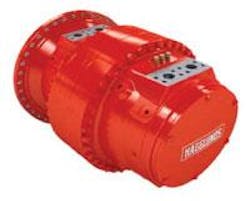High-power CBP motors can improve vessel layout and stability
Designers of vessels in the mid-power range have traditionally connected propulsion drives directly to the engine. This can limit flexibility with regard to the ship’s general lay-out, and the disadvantages are well known. However, Hägglunds Drives may have a solution in the form of a new high-power drive unit that will give power of up to 1MW from a single motor.
As yet, there are no offshore references, but the company believes the technology would best suit small to mid-size, special-purpose offshore vessels. The drives might also be applicable as top drive systems in drilling rigs, for mud pumps, and as auxiliary systems in dynamic positioning.
The new motors are available in various sizes from CBP 140 to CBP 840, with a maximum speed of up to 320 rpm. Subsequent continuous power capacity ranges from 800 to 1,200 kW for a single motor, depending on the motor’s size. As an example, the designation CBP140 means 140 Nm/bar torque is produced, so with a constant pressure of 175 bar, a torque of around 24kNm can be generated, and with a speed of 320 rpm, the motor power capacity would correspond to 800 kW.
The new range with its increased power capabilities opens up numerous possibilities, according to Hägglunds. For instance, the vessel propeller drive would no longer have to be connected mechanically to the engine with a long rotating shaft. In its place would be hydraulic pumps and just three hydraulic lines to the motor. This would eliminate all the engineering involved in designing and installing the long prop shaft, as well as the cost of the shaft and associated bearings.
This in turn would give the vessel designer scope to position the engine and propellers anywhere in the ship to suit the application. As an example, says a Hägglunds spokesman, the engine could be at a different level and angle to the propellers, while the latter could be designed to slew for steering, as the hydraulic motors connected with flexible hoses would move with the propellers.
In hydraulic terms, numerous propellers can be powered from the engine, opening up even more possibilities. “A single engine can be used to supply two or more propellers,” he says, “positioned anywhere in the vessel. Two small propellers placed at the rear may allow the vessel to operate in shallower waters, or if side-mounted, to give side thrust. They could also be reversed to give reverse thrust. There is a lot of flexibility in hydraulic systems, due to the fact that power is transmitted by fluid rather than mechanical components and shafts.”
Alternatively, two or more engines could be accommodated, with power shared between the drives, affording scope for improvements in the basic vessel design. “Two small engines may fit better than one large engine,” the spokesman adds, “giving improved stability and also offering redundancy. A knock-on benefit is that the engine power, which is traditionally connected to a prop shaft and therefore unavailable for other uses, can now be exploited by stopping or slowing the propellers and diverting the power to deck-based or other hydraulic equipment.”
The hydraulic motors can even be used in submerged conditions, he adds, and are maintenance free, providing long and reliable life. They are also quiet compared to mechanical drives because there are no high-speed elements involved, as gearboxes are eliminated. The motors provide high torque without the need of speed reduction units, and their mechanical efficiency is close to 98%, similar to that of a roller bearing.
Other characteristics of the new range include almost negligible inertia. According to the spokesman, this gives the operator a response to the drive not achievable with geared drives: examples include fast stopping capability in emergencies or frequent starting and stopping with controlled ramp up and down times.
The high torque from the motors is generated irrespective of the speed. “It may therefore be possible to improve the propeller design by using the high starting torque to allow the motor to operate at lower speeds, and therefore at lower noise levels. With the variable speed from the hydraulic system, and the constant power available because the engine speed is also constant, the propeller speed can be adjusted to suit requirements.”
Currently, the technology is aimed solely at newbuild vessels. “Hägglunds hydraulic drives are in general easy to retrofit,” the spokesman claims, “but it may not be so easy to change the propulsion system in an existing vessel layout. We have not done a survey into this specifically, and the idea of using hydraulic drives on propulsion systems is somewhat embryonic and generic. We are testing the waters, so to speak.”
Hägglunds motors are manufactured in Sweden to ISO9001 and environmental standard ISO14001. They are also used on all kinds of deck equipment, winches, carousels, mud pumps, and drilling equipment.•
For more information contact Lars-Goran Soderlund, Hägglunds Drives. Tel: +46 660 87223, fax: +46 660 87160, [email protected], www.hagglunds.com


